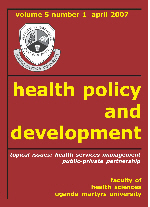
|
Health Policy and Development
Department of Health Sciences of Uganda Martyrs University
ISSN: 1728-6107 EISSN: 2073-0683
Vol. 6, Num. 1, 2008, pp. vi- vi
|
Health Policy and Development Journal, Vol. 6, No. 1, April, 2008, pp. vi- vi
In this issue ...
Code Number: hp08001
Dear Readers,
In this issue, your informative journal is back with two themes in focus. In keeping with the Human Resources for Health (HRH) decade declared by the WHO in 2006, this issue focuses again on HRH. It also looks at some issues in the management of health services.
The issue opens with a very incisive analysis and contribution to the ongoing debate on the possibility of legalizing abortion in Uganda and other African Union countries, especially after the signing of the Maputo Protocol. Our Guest Editor, Giusti, looks at the implications of taking a hard-to-reverse step on the basis of emotions. The paper questions the ethics of the common excuse of saving one person at the expense of a defenceless other, and uses the Hippocratic Oath to back its opposition to the legalization of abortion.
One of the most vexing questions in HRH management currently is how to determine an appropriate staffing level for health care services. Various methods have been used previously, such as the use of established bed capacity. However, one of the current methods in use argues that staffing norms should be based on actual workload. This Workload Indicators of Staffing Norms (WISN) method was proposed by Shipp for the WHO. Mugisha and Namaganda present the results of a study on the nurse staffing levels conducted in St. Mary’s Lacor Hospital, in northern Uganda, using the WISN method. They observe internal inequitable distribution of nurses and propose redistribution to ease pressure in some departments, and end up obviating the need for recruitment.
Kitanda presents the results of a similar WISN study to determine appropriate staffing levels for Tutors conducted in two Ugandan Schools of Clinical Officers. Basing on the actual workload, the study observes gross understaffing which is evidenced by extreme coping measures by both the students and the school management. This is probably the first study of its kind to analyse tutor staffing levels and is a must read.
Orach presents the picture of staff retention and attrition within the largest private-not-for-profit healthcare network in Uganda, the Catholic network. The paper looks at the HRH crisis as experienced by the Catholic network giving the trend, examining the reasons, the destinations of attritional cases and what the network is trying to do to improve human resource stability.
One currently difficult-to-know situation is whether patients take their medicines as prescribed. Governments, organisations, households and individuals spend a lot of money on the purchase of medicines. Moreover, studies have shown before that health workers prescribe and dispense a lot of medicines to patients. However, patient adherence to instructions and regimens is not very well studied, especially for chronic illnesses. Moreover, currently, many patients are enrolled on ARV and other chronic treatment regimens. It is therefore important to know the factors affecting adherence to chronic treatment in poor settings. Odaga et al., report on a study of adherence to anti-epilepsy treatment in the northwestern West Nile region of Uganda. They identify adherence-promoting factors, and adherence inhibitive factors.
Yawe and Kavuma present the results of an analysis of the technical efficiency of healthcare provision in a group of general hospitals in Uganda, using Data Envelopment Analysis. They analyse the output data by including and by excluding undesirable outputs such as deaths, arguing that most hospital output data exclude negative outputs. They produce mini-league tables grading the hospitals according to performance.
Whereas Uganda has recently just received long-hoped for and welcome news of improvements in maternal, infant and child mortality, most of which can be directly attributed to the efforts of the national EPI programme, Cicciò questions the sustainability of the gains, given that the approaches used to get the current high coverage are themselves not sustainable. The paper questions the frequent use of some approaches such as recurrent mass campaigns such as the National Immunisation Days, and their impact on the more reliable routine immunization.
Komakech takes the unfamiliar reader through the politics of international humanitarian action during crisis by using the northern Uganda experience. The paper highlights benchmarks in the history of international humanitarian action and shows some positive results of integrated planning and consolidated appeals for Uganda. Murru concludes the issue with a primer and detailed analysis of the politics of international aid and emphasizes whose agenda it serves.
Copyright 2008 - Department of Health Sciences of Uganda Martyrs University
|
